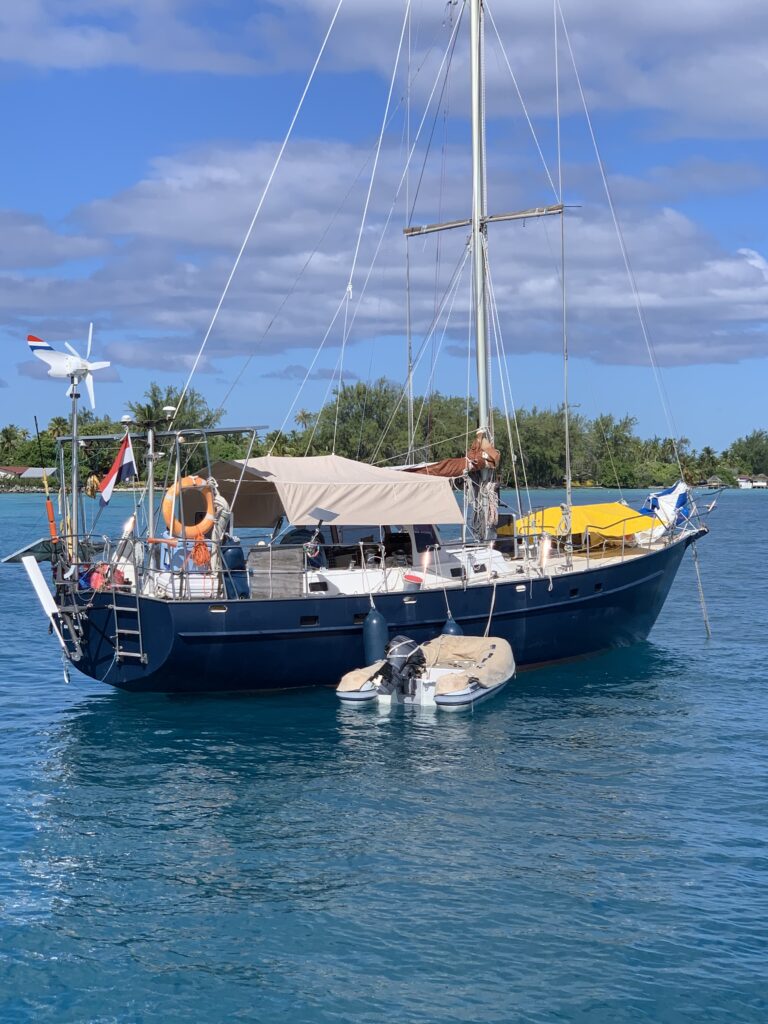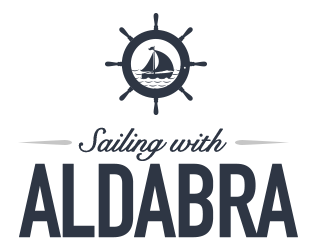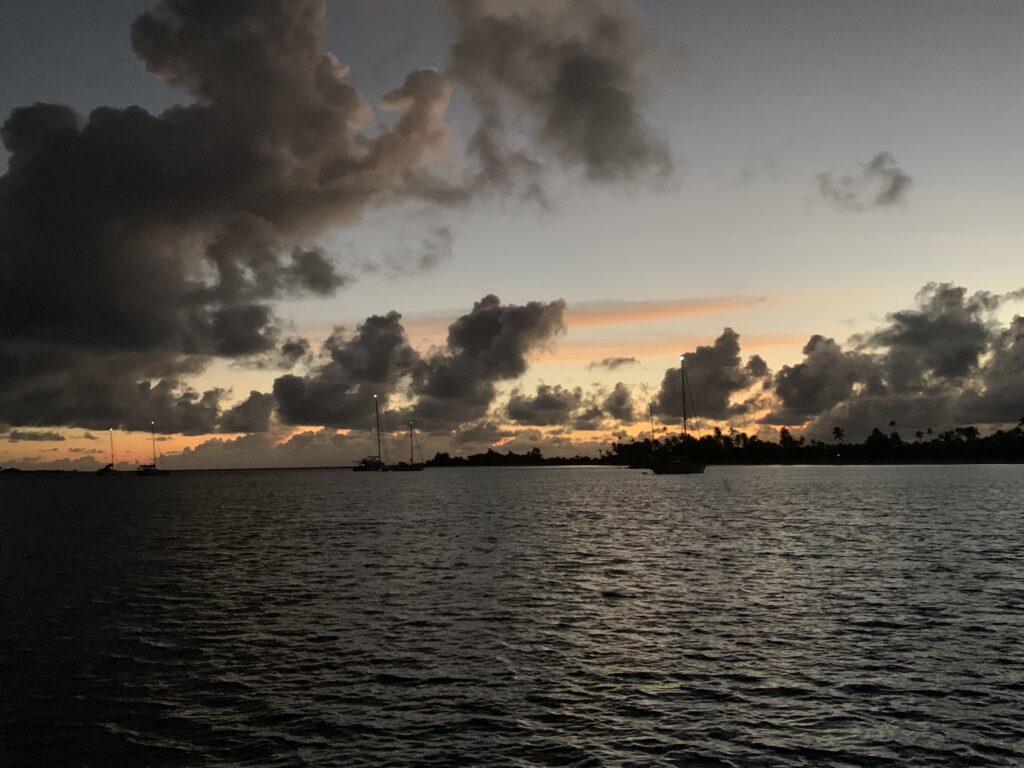
I’m sitting in the cockpit of Aldabra on Wednesday, May 31. We’re in the anchorage in front of Rotoava, the town on the atoll of Fakarava, population maybe 2000. The wind is coming from the southwest, bringing choppy waves that build from all the way across the lagoon (15 miles), and sitting on the boat is not very comfortable. It’s been windy and rainy for about twenty-four hours and probably won’t let up until tonight or tomorrow. Despite the conditions, Gabe flies out from here on Friday, so we need to stay put. I’ll be sorry to see him leave but I’m guessing he’s ready to get on with his summer plans. Cruising on a sailboat in the Tuamotus can mean long days of unfavorable weather, yet those are interspersed with moments of adventure on land, dramatic coral in the water and lots of wonderful people to meet. There are also many opportunities to fix things on the boat, especially after it had been sitting for a few months in Tahiti.
The Tuamotus are beautiful low-lying atolls that are made up of reefs that surround a lagoon. A few of these 76 atolls are inhabited with some infrastructure for locals and tourists. Others may have as little as a few subsistence farmers or fisherman. And still others are completely uninhabited. These atolls can be mostly submerged, or they can be made of motus, small islands that support the growth of some vegetation and people’s livelihoods. The people that live here mostly speak French and/or Tahitian, but those that work in stores or in tourism speak enough English to help me get by.
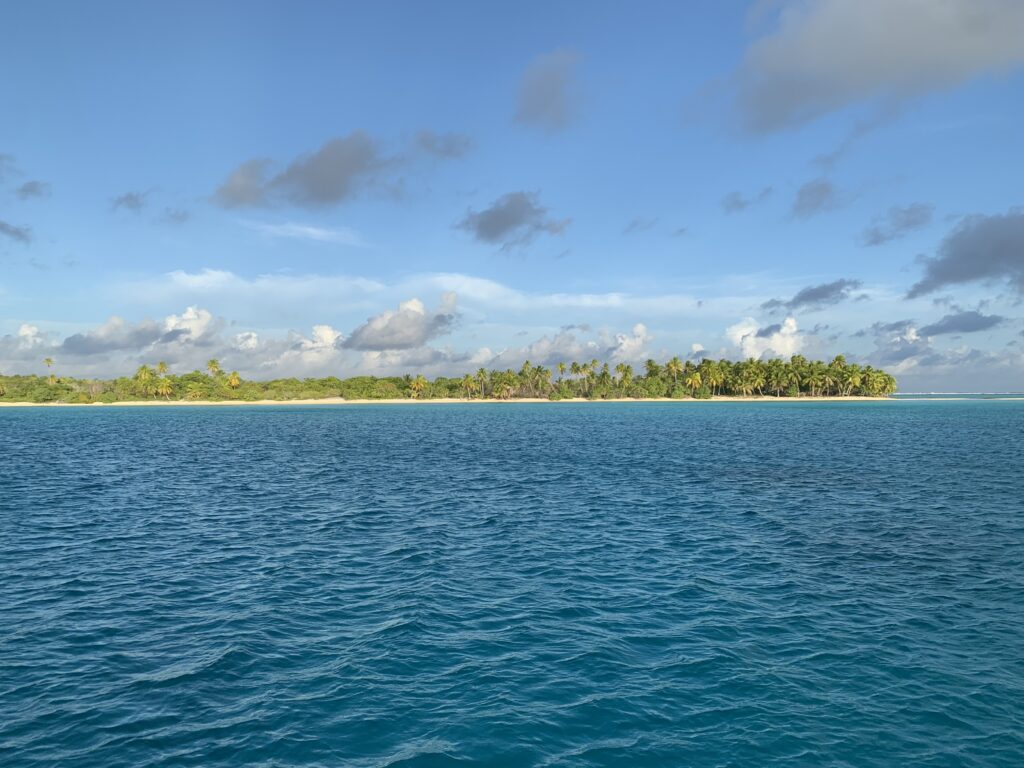
Not all the atolls have passes that allow you to safely enter the lagoon. For those that do, one must navigate through the pass when the tides and winds are in your favor, otherwise it can be quite a ride. Once inside the lagoon, you have protection from the open seas, and often you have protection from the wind, but to transit from place to place you must safely navigate the coral heads (called bommies), which could be hidden right below the surface and severely damage the boat. To anchor, you must try to find a sandy patch and then use floats to lift the anchor chain over the bommies on the sea floor. Anchoring itself is quite a challenge and can take multiple attempts to get situated. Gabe has become masterful at diving down to the anchor to reposition it or the chain, in all kinds of adverse conditions.
So, what have we been doing since we left Moorea? Here’s the way-too-detailed recap.
Our first destination was Tahanea, an uninhabited atoll that is a sanctuary for nesting birds, and a well-liked destination for underwater exploration of the three passes that lead into the lagoon. Cruisers also go to Tahanea to kite board.
Our passage to Tahanea was mostly smooth. Having left Moorea on Wednesday, April 12 at 6:30 a.m., we motored-sailed in very light air on the nose for several hours. In the mid-afternoon, the wind came up and very quickly we had a squall with 28-knot winds and rain. With the full main and jib flying, and seas building, I had to hand steer for some of it because the autopilot was overpowered. At one point we just took the main down for a while. In the evening, we put it back up with the first reef in, and had some spells of a nice beam reach in 10-14 knot winds.
For most of the next day we motor sailed in light air. The autopilot got fussy at one point so we used the backup CPT autopilot for several hours. The next day, Friday, April 14, we arrived at the gap between Faaite and Tahanea and turned right to round Tahanea. There was no wind and the seas were glassy. We entered the middle pass shortly after noon with no issues even though it was an hour and a half after high slack tide. (It seems to be the case that the passes are far less challenging when there has been no wind and the seas are calm.)
Tahanea
We anchored just to the west of the middle pass. No boats were there at the time but two came in shortly afterward. It took more than one attempt to set the anchor down in sand instead of coral. We did our best and had a good night’s sleep that night. The next day we spent quite a bit of time trying to re-anchor. We had been rubbing on some coral at night and we wanted to get the anchor down in a better spot and float our chain above the coral heads. After a few attempts, we thought we had it right so we took the dinghy to shore to explore the nearby motu and snorkel a bit. That night we had lightning and rain. A boat from Slovenia, Timy, came in and anchored very close to us.
The next day, Peter and Natalie from Timy dove on their own anchor and then checked ours out. They discovered that we were caught on some coral so Peter helped Gabe get the chain off the coral. It was quite an operation and we were very grateful. They had just come from the Marquesas with one shroud not working to keep up their mast. They had rigged some lines for support but really needed to get to Tahiti to pick up the part they needed. We took over some coffee and chocolate and they gave us the password to their Starlink. Suddenly we were really happy that they were anchored so close to us.
While we were trying to re-anchor, the windlass was having trouble pulling up the chain. Gabe and I took the windlass apart and cleaned debris from it. The anchor chain had sat for several months in Port Phaeton and it had a lot of rust that was flaking off into the windlass. That day we stopped by and met the folks on another nearby boat, Agape, who are from the U.S. but have been in the Tuamotus for a few years. We also met Greg and Robin on Salty Dancer, who are from Oregon.
On Monday, Gabe and I took the dinghy to the west pass to see if we could snorkel in it. It seemed a bit rough so we backtracked and snorkeled east of the pass. While doing so, Gabe got stung by a jelly fish and had a rather severe reaction, which fortunately subsided in a few hours. The winds picked up from the east in the afternoon and we had a windy night.
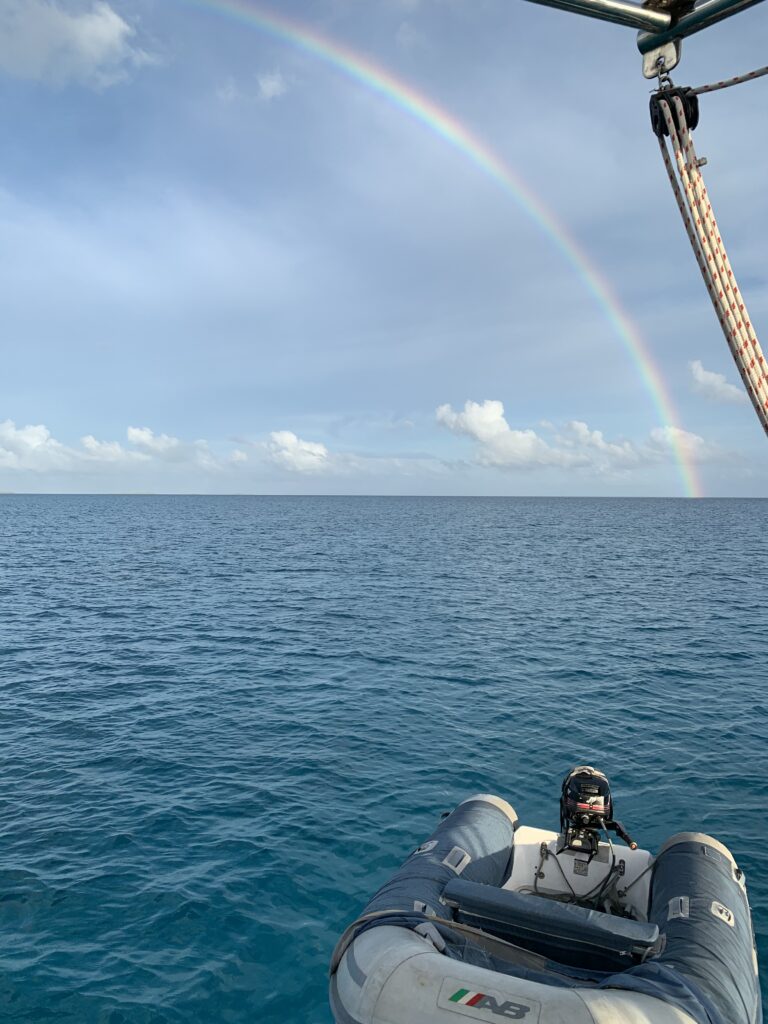
While we were anchored, I was slowly working on the stuffing box that is connected to the prop shaft. It was dripping a lot and I thought it might be why the bilge was filling with water more than it should. After putting some Gibbs penetrant on it and then later some vinegar, I got the nut to move and then tightened it a bit. While I was doing that, I realized that a part on the water pump had a crack in it and fresh water was spurting out and going into the bilge every time we used the water pump. I replaced that part, which slowed down water entering the bilge.
The next issue to address was that the wind generator was making a strange noise and was vibrating. Plus, the controller box was getting hot. We tied off the wind generator until we could troubleshoot the issue.
On Wednesday, Gabe and I took the dinghy back to the west pass but it was windy and rainy and we aborted the attempt to snorkel. We ran into Greg and Robin on Salty Dancer and invited them over for sundowners for that evening. In the afternoon, we tightened the hex bolts on the wind generator but didn’t fix the problem. I cracked the nose cone trying to put it back on. Fixing the crack with epoxy didn’t help so we were resigned to not using the wind generator until we could get new parts. That afternoon we took the dinghy to a different motu and explored. Then had a nice visit with Greg and Robin that evening.
By Thursday, the wind was out of the north in the mid-teens and the anchorage was uncomfortable. I started taking inventory of issues on the boat. With the wind generator out of commission, we had to run the motor each night to keep up with the refrigeration. Then the nozzle for the stern shower cracked. We tried to fix it without success so we started taking showers using a jug, which has worked pretty well. Then I noticed a slight drip out of the housing for the watermaker’s carbon filter, but I could not unscrew the housing, so the drip is just going to have to persist. I also noticed that the alternator belt started making a screeching sound. There was a lot of black just around the belt so we replaced it easily.
On Friday, we continued our repairs and tried cleaning the boat bottom, but the seas were just too rough to accomplish much and the day was otherwise uneventful.
With the wind and seas still rough, we took the dinghy on Saturday over to the east side of the middle pass and explored that motu, both on land and in the water. On the ocean side, the “land” was a large expanse of dead coral. On the lagoon side, we saw coconut palms and other vegetation. It was a bit of a challenge getting back to the boat in the dinghy as we fought standing waves across the pass. The unfavorable conditions kept us uncomfortably on the boat on Sunday. Finally on Monday the winds let up a bit. We pulled up anchor and headed down to the southeast corner of the atoll. The winds lightened up so much that we motored the whole way and ran the watermaker. We anchored before noon and floated our chain. We were the only boat there and enjoyed snorkeling near shore along a wall of vibrant coral.
It would have been nice to stay where we had successfully anchored, but we wanted to take advantage of a small weather window to go to a famous bird motu on the west side of the atoll. Other cruisers refer to it as the Number 7 anchorage because the reef looks like a 7 from the air. We got there and anchored in front of the motu and snorkeled from the boat to shore. We walked the perimeter of the motu to keep from disturbing the nesting birds. We saw lots of boobies nesting and some terns. We waded across a channel to another motu and met a Tuamotu Sandpiper that was quite friendly. It’s probably why its numbers are diminishing. I was sorry that we weren’t banned from those motus. The last thing those birds need is people hanging around. We snorkeled back to the boat and passed over a really rich coral habitat with lots of fish. Probably the first really good habitat we’d seen since arriving in Tahanea.
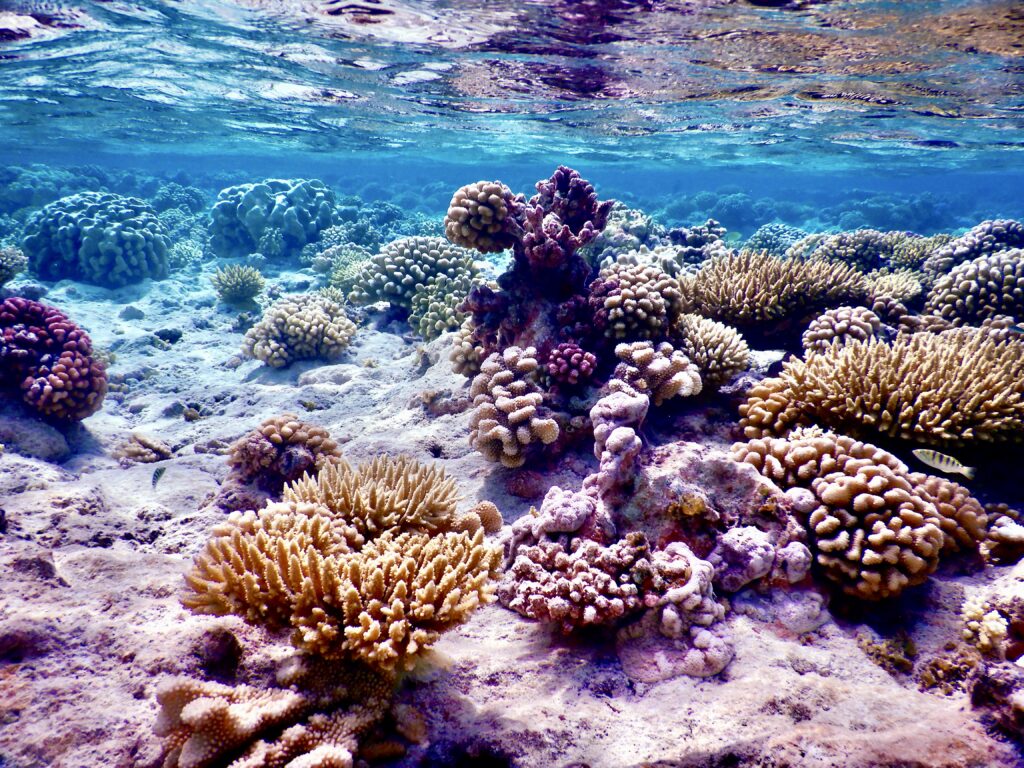
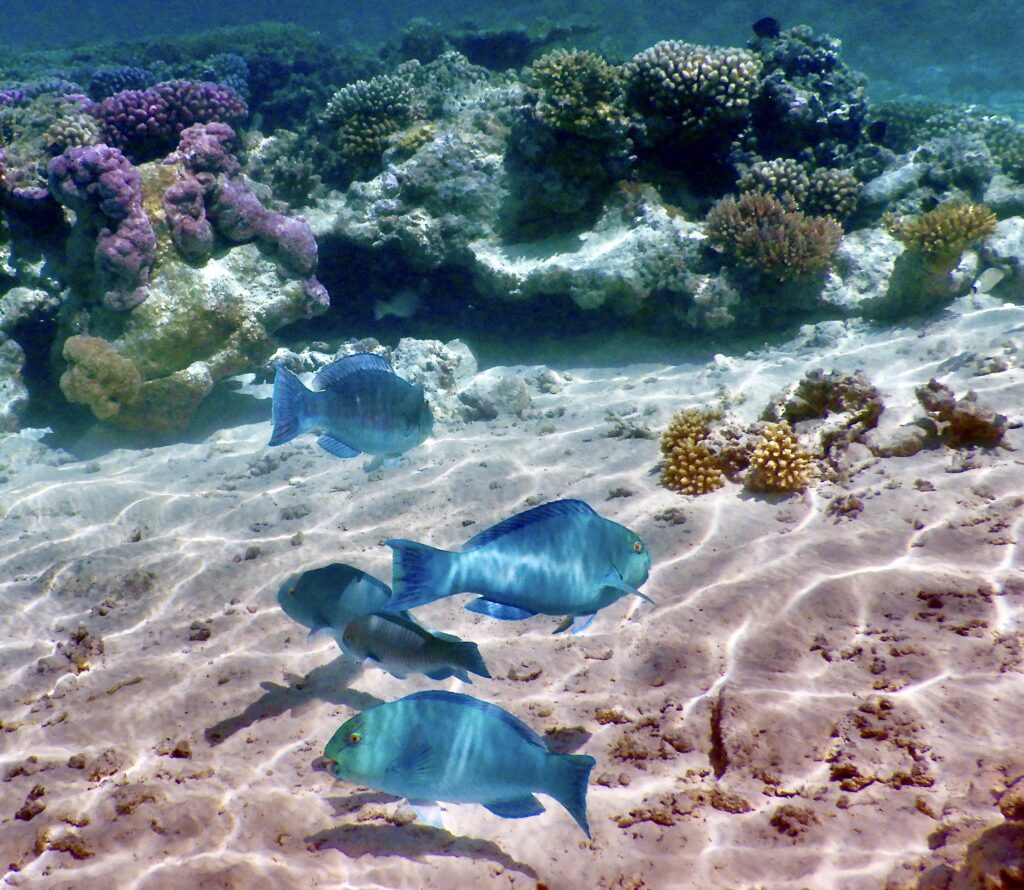
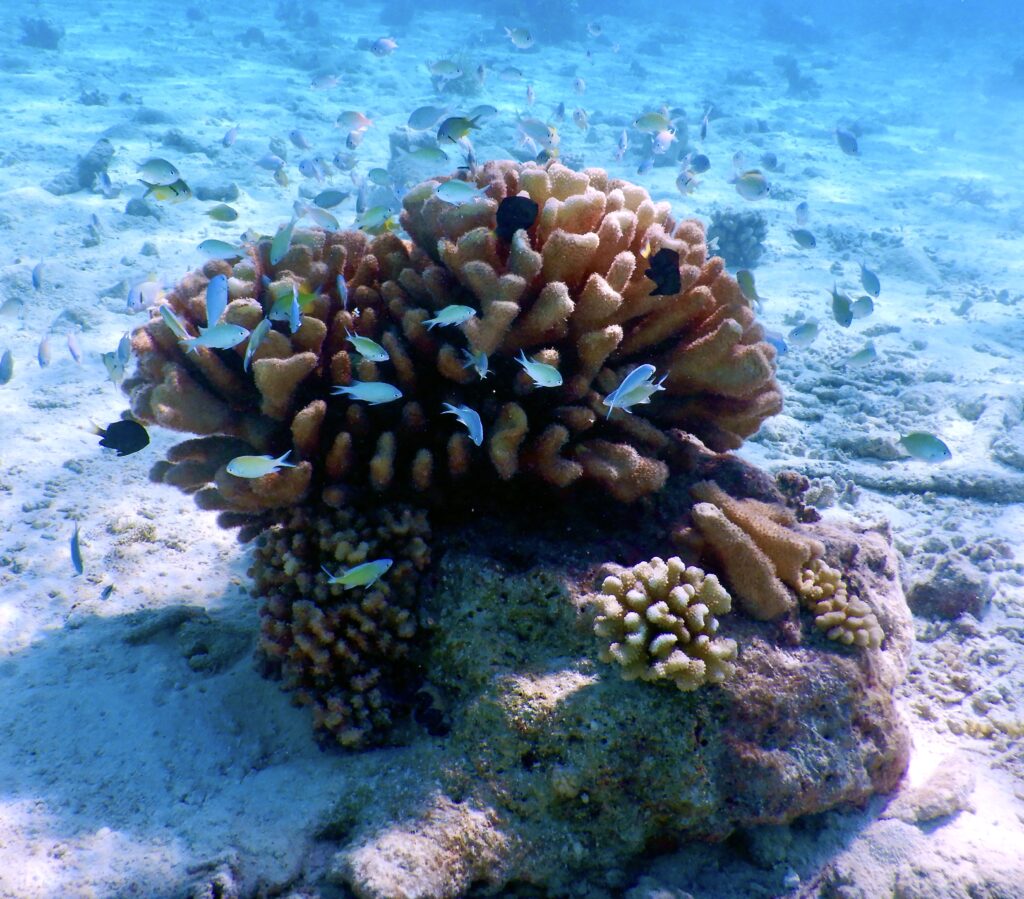
That night was windy and choppy and not a good place to remain. So the next morning we pulled up anchor and returned to the southeast corner. When we arrived, there were several boats there and more showing up. It seemed to be a pack of family boats, headed by a large German catamaran called Moin. They shared all kinds of activities and even had their own dedicated radio channel. One night the kids all had a sleepover on the beach without the parents. They called it “Survivor Island.” We never found out how that went. The next night they had a bonfire on the beach and invited the non-kid boats. We went and enjoyed meeting several of their delegation.
While we were at the southeast anchorage, we walked around the motu in front of us. We got a bit lost in the bush and ended up circumnavigating the motu because we couldn’t find a way to cut through the jungle in the center. We also got the kayaks out and kayaked to the motu just to the east. On the way back we stopped by a boat that had just come in, Chip and Kristina on Second Set.
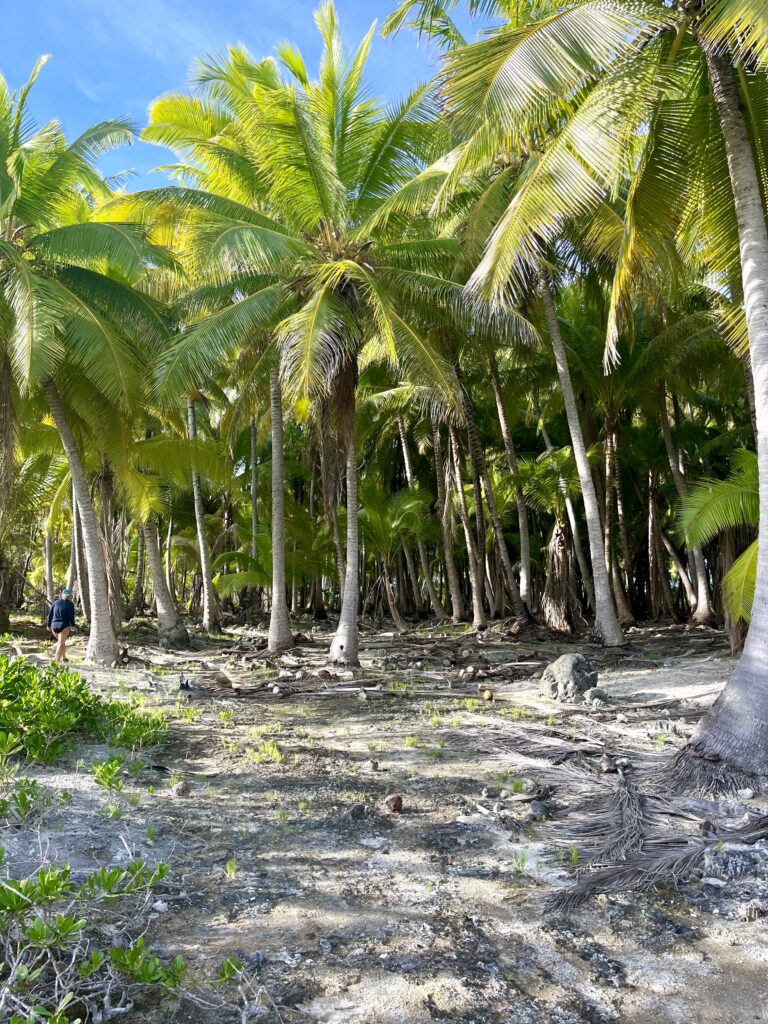
Back on the boat we discovered that one of the two feed pumps for the watermaker wasn’t working. Upon closer investigation, we discovered that it was leaking salt water into the bilge. We replaced it with the spare pump and it seems to have solved the problems with water in the bilge.
During this time, a big wave event was occurring in French Polynesia. The water was so high coming toward the atolls that huge waves were crashing on the reefs and several of the passes in the atolls were temporarily closed. The spray from the waves could be seen from miles away. Then, on Tuesday, May 2, we downloaded weather and saw that big winds might be coming from the southeast. It would mean that we might be confined to that anchorage for more than another week. Returning to our first anchorage wasn’t really an option because it would be uncomfortable. We really wanted to snorkel at least one of the passes, but it wouldn’t be feasible for the foreseeable future. Another option was to proceed to Fakarava. We had been without Internet for quite some time. If we were going to be pinned down by winds, at least we would have service in Fakarava.
We thought we might be able to snorkel one pass that day and then exit the pass in the evening and do an overnight sail to Fakarava. But when we got to the side of the atoll with the passes, it was clear that we weren’t going to be able to snorkel a pass. The winds were in the high teens, low twenties. We had to anchor somewhere so we could take the motor off the dinghy and secure it to the big boat. So, we anchored near the northwest pass long enough to do that. Then, instead of waiting for evening, we would exit the pass in the early afternoon and sail to the north Fakarava pass because we would get to the south pass too early. A very large National Geographic exploration ship went out of the pass at slack tide. We should have called them for a report but didn’t. Instead, we followed them out, about 45 minutes later, and had a very lively exit. We were motoring against large standing waves that were crashing over the top of us. The effects of the earlier wave event were still apparent. Once we got out, we had big seas for quite awhile as we headed toward Fakarava, and Gabe was out of seasickness meds.
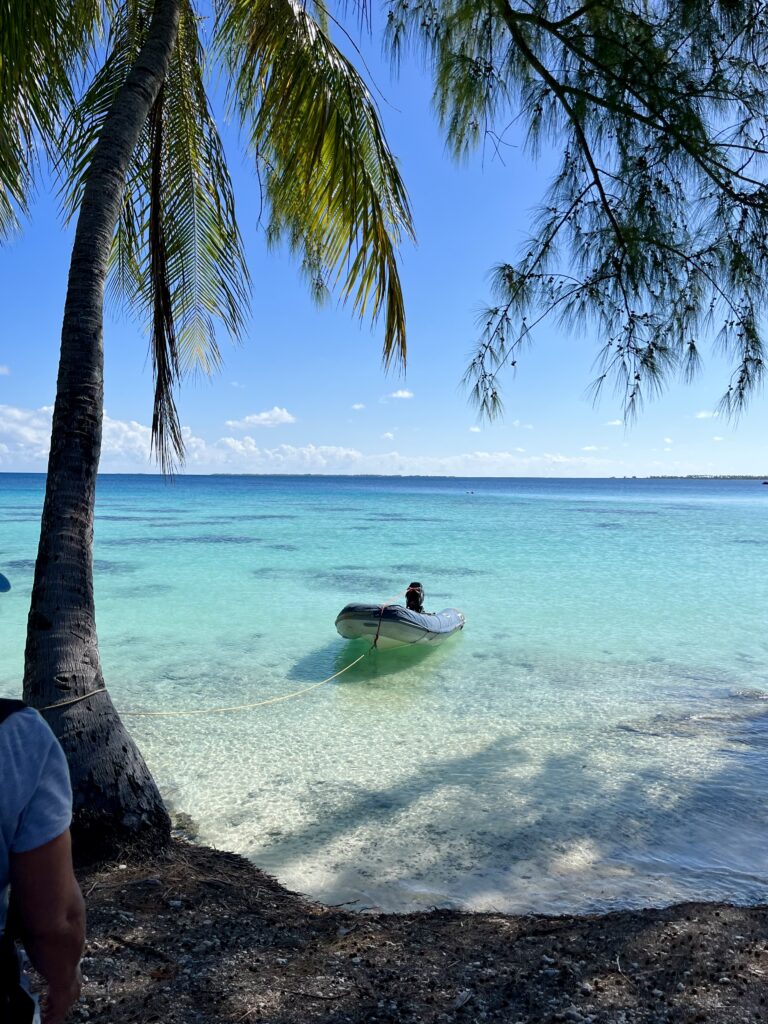
Fakarava
We sailed with just the jib to the Fakarava north pass. The winds were inconsistent so sometimes we moved along quite well and other times we turned on the motor to help with speed and to charge the batteries that were being drained by the autopilot. We saw sunrise as we were approaching the north side of the atoll and entered the pass about 8:00 a.m., an hour and a half before slack. We were unsure if slack tide was going to come according to the tables anyway because of the unusual wave event. We had significant current against us and it felt like we were just sitting in the pass for an eternity as we made 1-2 knots progress into the atoll. Salty Dancer was just leaving the anchorage as we arrived so we said our goodbyes over the radio. We anchored in front of the town, Rotoava, spending the rest of the day on the Internet and recovering from the high waves during the sail. I ordered a lot of parts that my bother-in-law, Pat, can bring when he comes in June.
On Thursday, May 4, after a good night’s sleep (I stayed up all night on the passage), we got up early and put the dinghy in the water. We went to shore and disposed of our trash and our recycling. We talked to the guy at the fuel dock about hours and bought a couple of groceries. The supply boat had just come in but it didn’t bring any produce. We then headed over to Fakarava Yacht Services to drop off a butane tank for a refill, along with a couple of bags of laundry. Then we went to one more grocery store (for beer) and then headed over to the Havaiki Lodge for lunch – burgers. We then spent a windy afternoon on the boat.
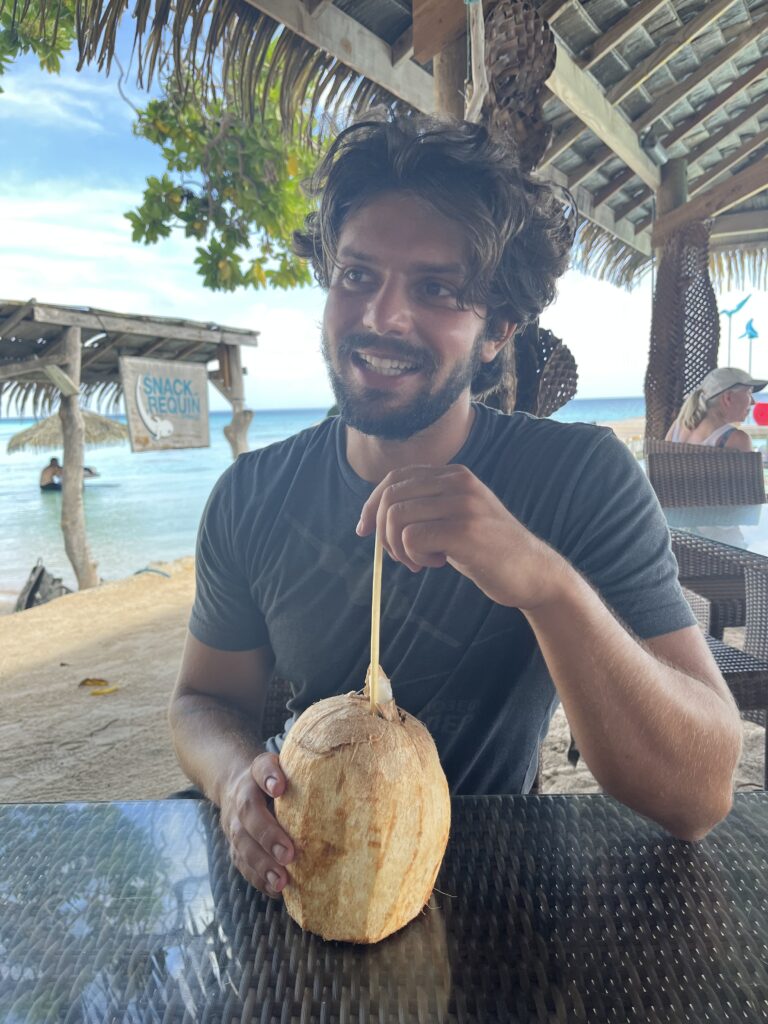
The next day we went to the pearl farm tour at the Havaiki Lodge, where Gabe bought an oyster with a pearl.
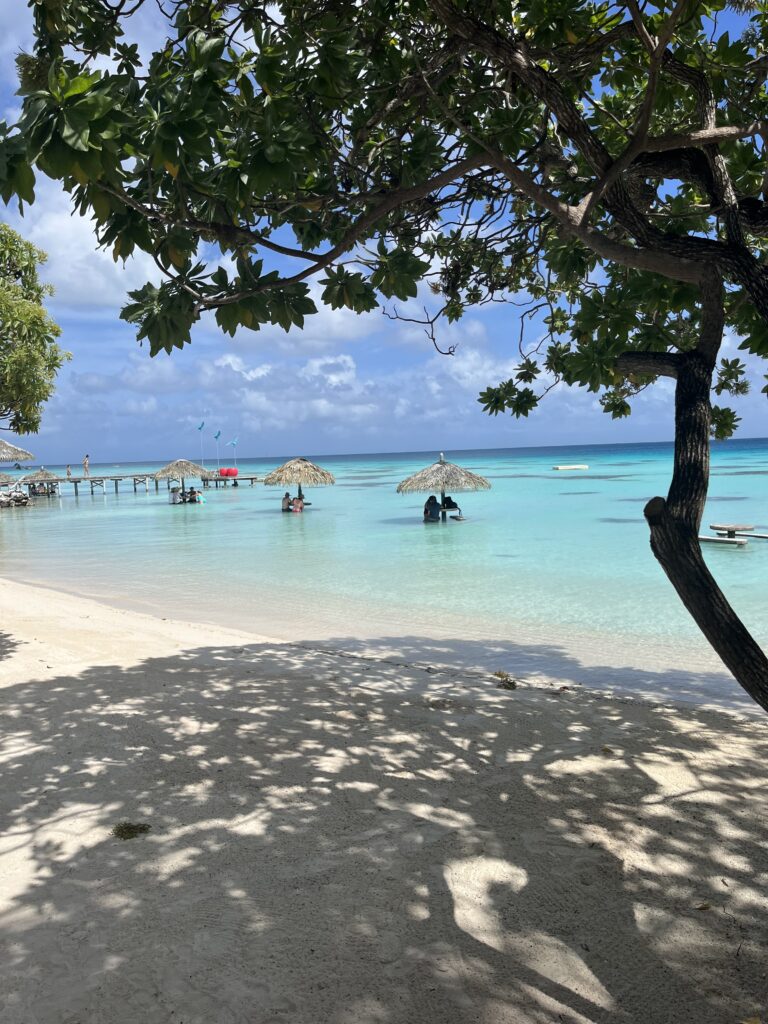
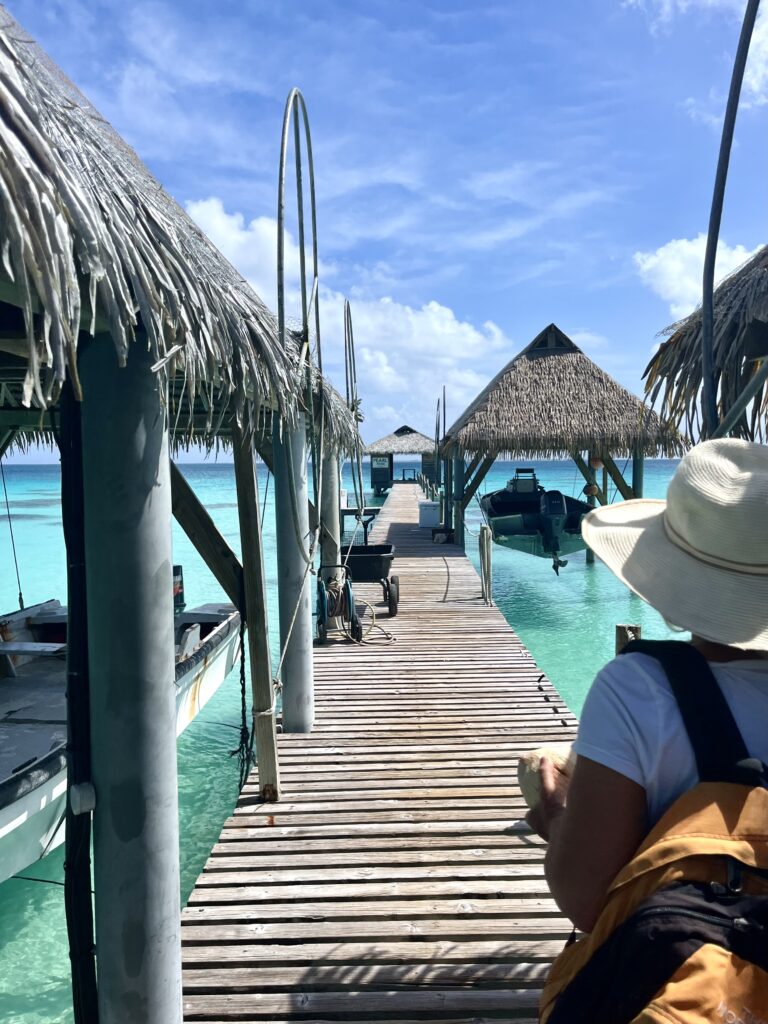
Then we got 4 jerry cans filled with diesel and headed over to the Rotoava Grill for lunch. We met Kaitlin and Tommy from Southern Cross while at lunch. They are from Tennessee, which was fun for Gabe.
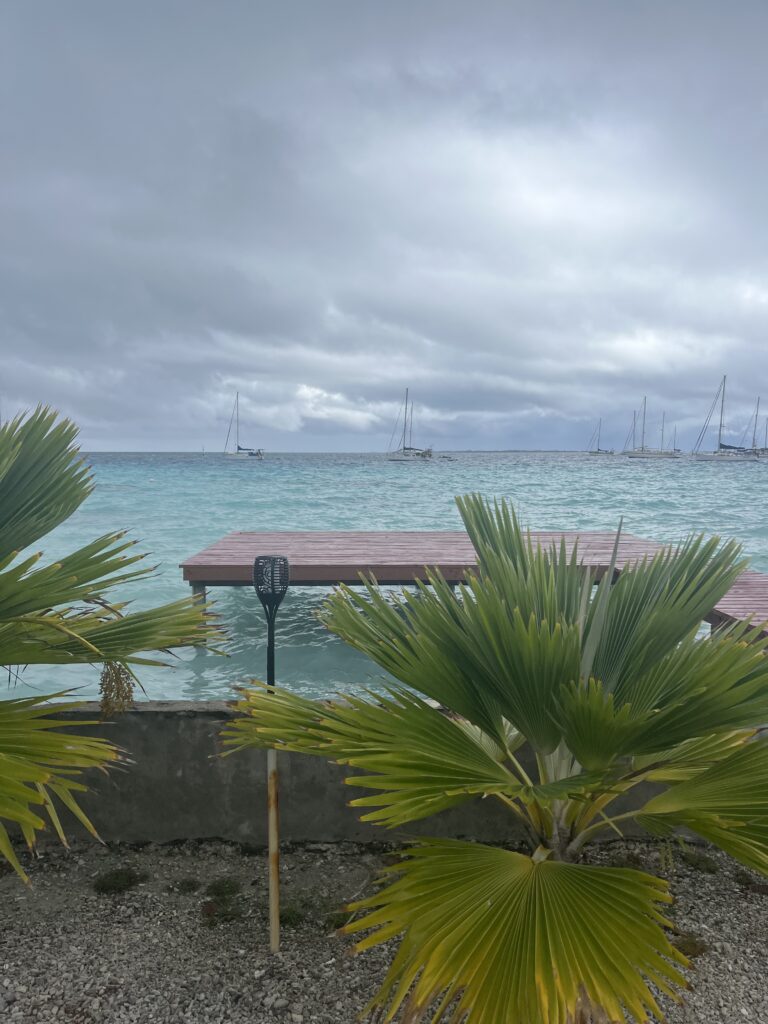
On Saturday, May 6, we picked up our laundry and butane tank from Fakarava Yacht Services. We then went back to the boat, put the dinghy up, pulled up the anchor and headed halfway down the atoll to a deserted anchorage near a reef. We spent the night, snorkeled the next morning and then continued traveling to the south pass anchorage. We picked up an available mooring ball in the early afternoon and then snorkeled near the boat.
The south pass area of Fakarava is amazing. The water is crystal clear and there are large swaths of healthy coral on the lagoon side of the pass and in the pass. On Monday, we snorkeled on the lagoon side of the pass and then inside the pass itself before having lunch at the restaurant of a local dive hostel. In the afternoon, Gabe worked on cleaning Aldabra’s prop.
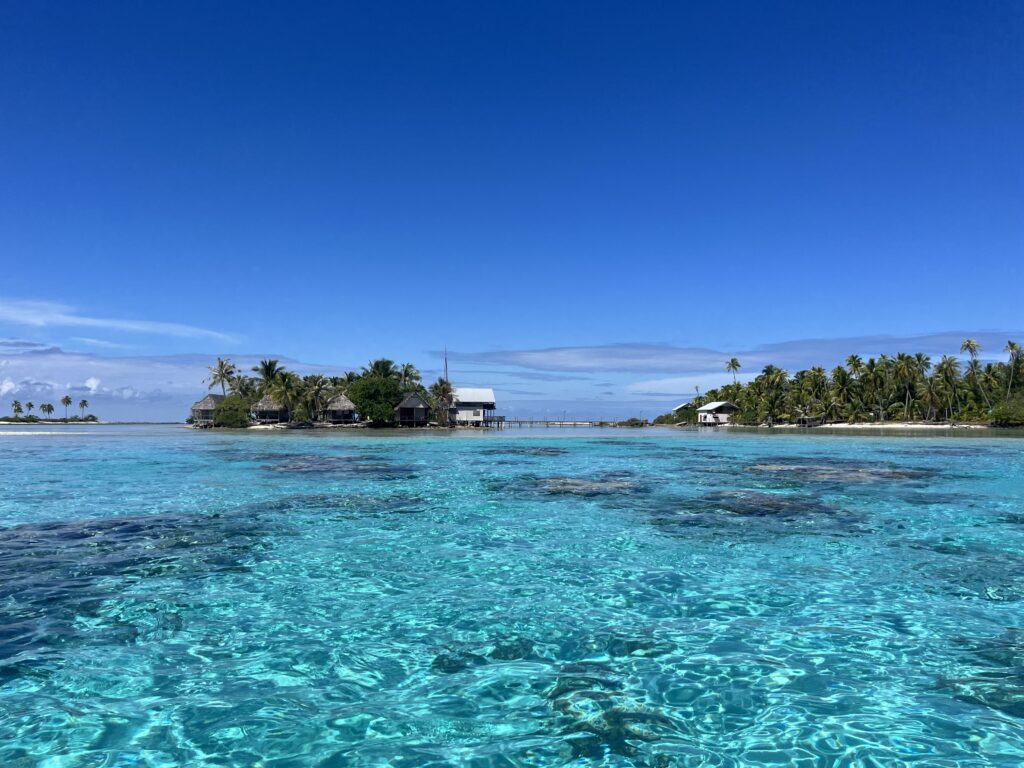
In terms of issues, the Internet went down for a few days and we noticed that the fridge was having trouble getting cold. We transferred frozen food from the Engels to the freezer and put important cold food in the Engels.
On Tuesday, we snorkeled in the south pass in the morning and then headed over to the southeast Fakarava anchorage, Hirifa. We wanted to get there in anticipation of significant wind expected from the southeast. That night, as we sat on the boat, several giant manta rays would circle the boat upside down, then do a somersault. They stayed at the boat for a few hours while we watched.
Wednesday, May 10, started out calm. We took the dinghy over to say hello to Chip and Kristina on Second Set and then went ashore to explore. While we were ashore, a squall came up and we headed back to the boat. Over the course of the afternoon and night, the wind and rain kept building. At about 3:00 in the morning we both heard a big sound, as if the anchor had popped and hit coral. At first we just monitored the situation from the cockpit. The winds were between 40 and 60 knots and the lightning was exploding all around us. We noticed that we were near another boat and thought they had dragged their anchor. But in truth, we had dragged and we were dangerously close to them. We turned on the motor and used it to keep away from the other boat – Pura Vida. But every time we had a lull in the wind, Gabe would go up to the bow to first take the snubber off and then slowly pull up the chain. It took a while but he eventually got the anchor up. We then went outside of the anchorage and motored around in circles until dawn, about an hour and a half. Then we went back and re-anchored.
We had a quiet, uneventful Thursday. Then, on Friday morning, the wind shifted from southeast to northwest. Now we had waves building as we faced away from the shore. We didn’t realize that all the hobby horsing made the snubber come off the chain. As a result (because the windlass clutch had come loose), we had about 100-150 feet of chain pay out, and now we were too close to other boats once again. We didn’t know that the clutch was loose, all we knew was that the windlass wasn’t picking up the chain. So we were using a halyard and the snubber, alternately, to pull up the chain. Peter from Pura Vida came over to help. He drove the boat while I pulled up chain and Gabe was in the water directing us around coral hazards. We finally got enough chain up to stay in place. A short while later, Greg from Escape Velocity, who had watched us try to pull up the chain without the windlass, came over and asked if he could look at our windlass. He tightened the clutch and helped us replace the broken spring and everything worked! What a relief. My back was rather sore for a few days but I was so grateful that the windlass was operational.
On Sunday, we put the dinghy on the boat and headed back to Rotoava, motoring against medium winds all the way. Once we anchored, Chip and Kristina paid us a visit so we could compare notes on all that happened during the storm. (Lots of boats had issues that night and one went up on the reef.) Then, we made phone calls. It was Mother’s Day and my mother’s birthday.
The next day we put dock lines and fenders on the boat and headed over to the fuel dock to fill up with diesel and gasoline. Our anchor spot was taken while we were away so we picked up a mooring ball and then went to the Havaiki Lodge for lunch. We met Glenn and Oana from Cloudy Bay there and had a chat. When we returned, we got kicked off our mooring ball and then searched for a new place to anchor, which was becoming more difficult because the anchorage was filling up in anticipation of the supply boat’s arrival.
On Tuesday, Gabe and I rented bikes and rode to the north end of the atoll and then back south. We had lunch at the Havaiki Lodge again and saw Cloudy Bay along with another boat we had seen in Hirifa. We later met Katie and Bill on Flite Deck, a boat I had seen in San Diego.
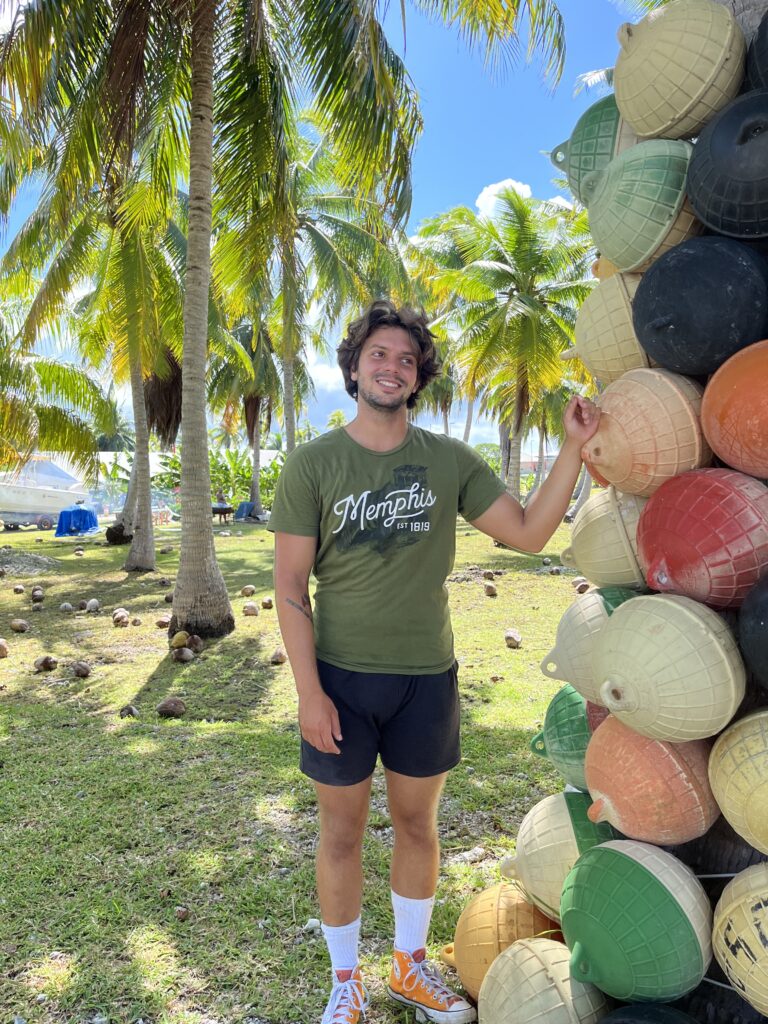
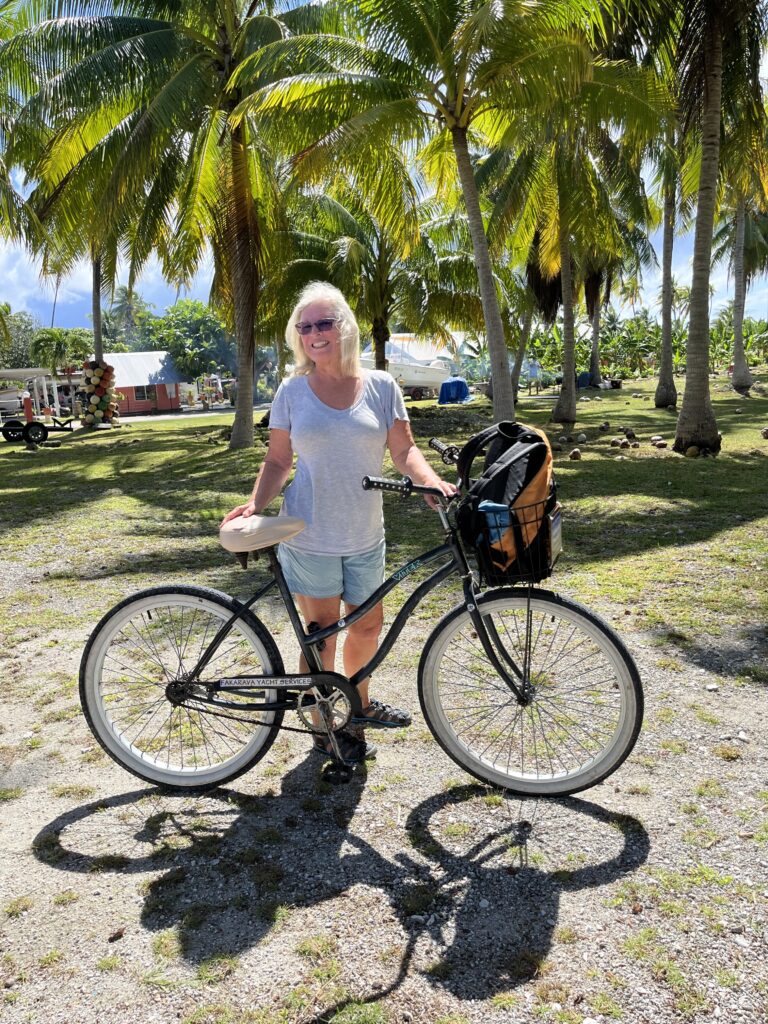
On Wednesday, we had lunch at the Rotoava Grill with Chip and Kristina and saw Katie and Bill there as well. Then on Thursday the supply boat came in. We thought we would go to the stores in the afternoon, after the shelves had been restocked. But we decided to go in early to see if they had any eggs, which are sourced locally. As soon as we got to one store, we learned that they were just about to bring out the produce. So we were there to start grabbing apples and oranges and potatoes. I left Gabe there and walked up to the store at the fuel station. There was a huge crowd of people waiting to get in, many who had been waiting at the door for three hours. I joined them and about an hour later the doors opened and there was a mad rush. Gabe was there by then as well and we managed to get some limes, onions, tomatoes, oranges and apples. We were not aggressive enough to get cucumbers. It was a crazy melee but we felt successful. We capped the morning off with another lunch at the Rotoava Grill.
Toau
On Friday, May 19, we pulled up anchor and exited the Fakarava north pass around 9:00 a.m. without incident. Outside the pass, we put up the main and the jib and made our way on a reach in rather light air. We arrived at the Otugi pass on Toau in the mid-afternoon. We turned left and followed Moin to the southeast anchorage, picking up one of five mooring balls. Second Set was there anchored. And Moin anchored over near Auryn, a friend of theirs.
It was a very quiet night except for the happy voices of children playing on shore. Toau is an inhabited island but with very few families living there. The next day, Gabe and I took the dinghy over to a nearby motu. We snorkeled and walked around the motu and met the family on Auryn.
We would have liked to stay longer at this anchorage. But in looking at the weather, we had only a brief window to go up to the north anchorage, referred to as the false pass. We had read that it had great snorkeling and a very nice family to visit. So on Sunday, we got up early and motored to the Otugi pass. It was a tiny bit challenging getting out, but we exited and motored up and around to the top of the atoll. The entrance was easy and we picked up a mooring ball. Moin was there and hailed us on the radio. We put the dinghy in the water and went ashore to meet a couple who owned the motu, Valentine and Gaston. It was Sunday, so their day of rest, but we arranged for Aldabra and Moin to have lunch there the next day. Then Gabe bought a couple of pearls from Valentine and we went back to the boat to go snorkeling.
Before lunch on Monday, Gabe and I took the dinghy deeper inside the little bay and snorkeled. Then we headed to shore. Valentine and Gaston are very nice people and we enjoyed getting to know them, along with the family from Moin. They had a very engaging cat that several of us played with. And perhaps there are fleas because of the pets. I came away with dozens of bites, from head to toe.
Mindful of weather, Gabe and I got up early on Tuesday morning and left the anchorage at 5:30 a.m. We motored clockwise around the atoll. Once we cleared Toau and were between Toau and Fakarava, we got enough wind to sail for a couple of hours. We were early to enter the Fakarava north pass so we just sailed slowly, until the waves were too much for the light wind. At that point we started motoring again, arriving early at the pass with no ill effects. We went back to the Rotoava anchorage and anchored, but weren’t happy with our position relative to coral heads.
The supply boat was in on Wednesday so we went into town for groceries, without the mad rush of the week before. On the way back, we stopped and met Don and Gloria from Windswept, a Monterey boat that I have been in email contact with for the last couple of years. Then we went back to the boat and re-anchored, taking a lot of care to get it right because it will be in the same spot for more than a week, as Gabe prepares to fly out and I wait for Pat and Bill to arrive.
Early on Thursday morning, both our refrigerator and freezer went off at the same time. Not wanting food to spoil, Gabe and I got to troubleshooting with a sense of urgency. We called my friend Chris in Santa Cruz for advice and spoke to him multiple times as we investigated the failure. Eventually we found a blown 15 amp fuse and when we replaced it, both units started up. But the fuse holder was hot and charred, so we thought we should replace it. In doing so, I messed up the new fuse holder and we didn’t have another spare. So we tried to splice in a different kind of fuse holder. Unfortunately, nothing we did after that produced a positive result. Thinking it might be the splice, we redid it twice. Finally, Bill from Flite Deck came over and determined that the issue was with the wire that connected the fuse holder we were trying to use. Because that couldn’t be used, he took the fuse holder that I messed up and rehabilitated it well enough that it could be used temporarily. He then reconnected all the wires we had removed in our troubleshooting. By now it was early evening but we ended the day with cocktails and dinner on Bill and Katie’s boat.
On Friday morning, we went to shore to see if any of the stores had fuse holders. They didn’t, so I ordered some from West Marine that Pat can bring with him. Then we had lunch at the Rotoava Grill with Bill and Katie before starting to put the boat back together. (For any project, like one that takes place in the battery compartment, I have to take several bins out of their normal storage locations and put them in the cockpit or somewhere in the salon. I then have to take out various bags of tools. When a project is underway, you can’t walk anywhere on the boat.)
We finished putting bins back in place on Saturday morning and said goodbye to Flite Deck as they headed to Toau. The rest of Saturday was spent reading on the boat. The expected wind had come up and the anchorage was rolly and uncomfortable. Plus, we seemed to have run out of Internet data. Saturday night was quite windy although it was dropping off by Sunday morning.
On Sunday morning, we went to church and the singing was lovely. Then we came back to the boat for a lazy day of reading and writing, after replacing one of the head pumps, which was leaking, perhaps with a crack.
Monday was a holiday, but we did go to the Havaiki Lodge to inquire about a boat tour to the other side of the lagoon. We also met Scott and Tammy on Animal Cracker and Chris on Lightspeed. He is from Santa Cruz. Tuesday, yesterday, is when the wind and rain started, so we have been confined to the boat except for lunches on shore. The only thing I accomplished was to fix the dinghy pump, which we use daily. One of the air chambers on the dinghy has a hole in it. I need to work on that when we can be without the dinghy for a couple of days.
Post script. Gabe and I had been trying to go on a tour of the “Green Lagoon” on Fakarava but they weren’t running them because of weather. Finally, on the morning Gabe was leaving, we got to go on the tour. The first stop was the Green Lagoon, which was on the northwest side of the atoll between the out reef and the main lagoon.
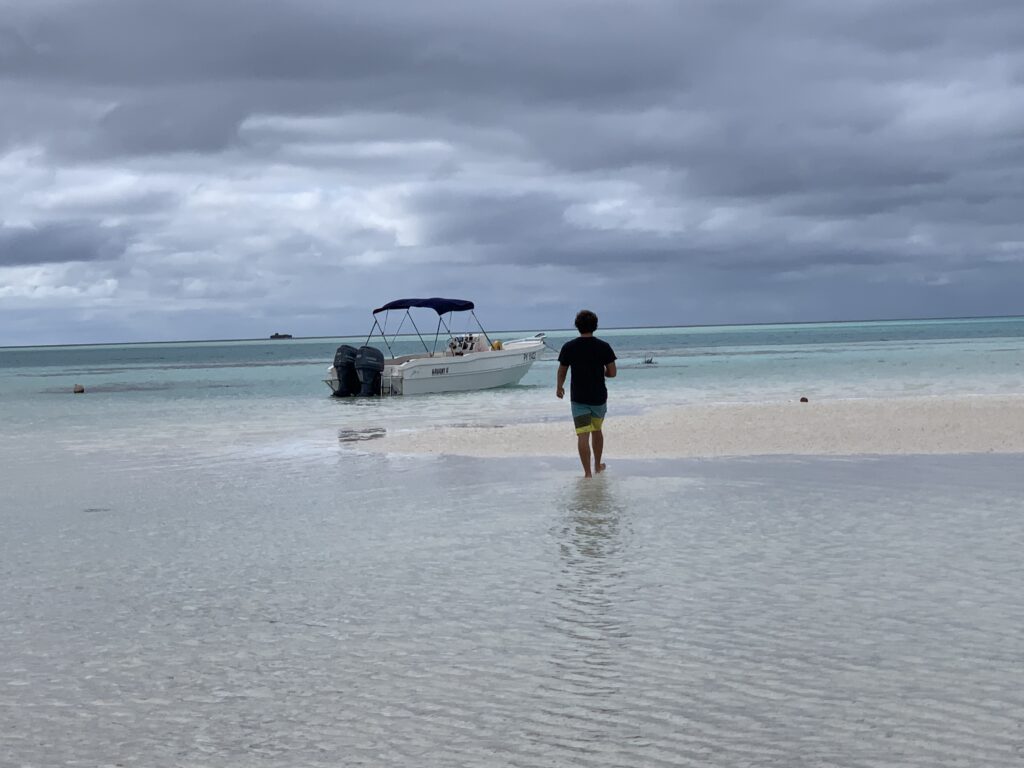
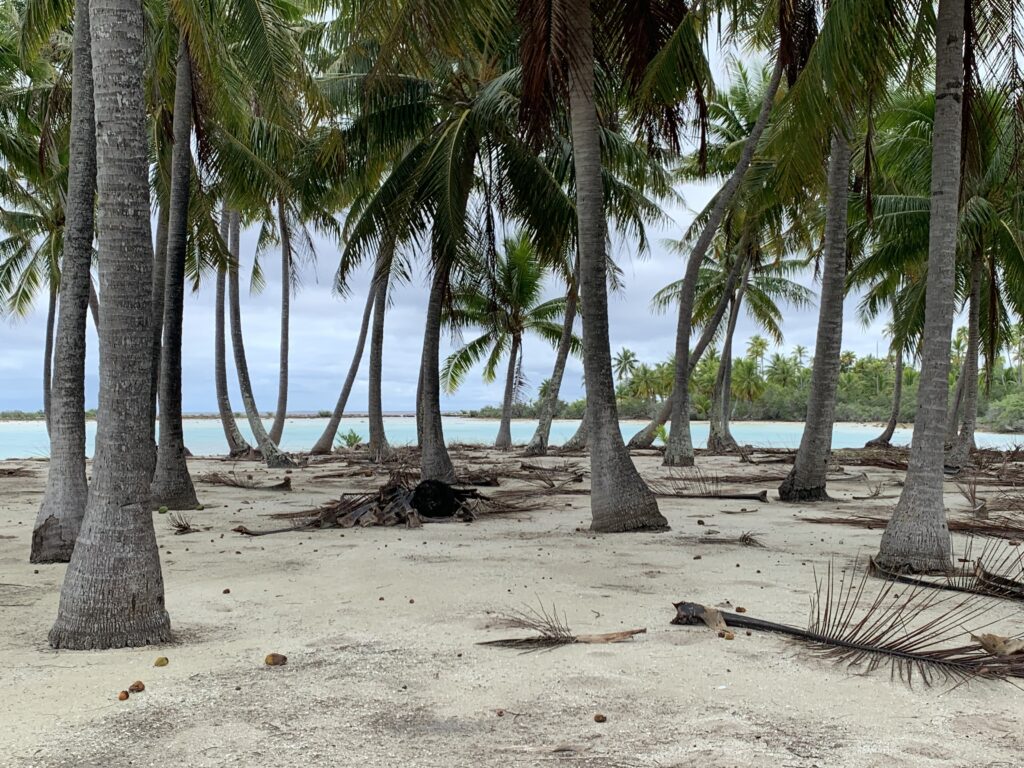
It is so nice to meet local people and to meet the other cruisers. I have mentioned some of those we’ve met, but not all. And there are so many more in each anchorage that we see and don’t meet. But even with the folks that we do become acquainted with, we spend very little time getting to know each other before we go our separate ways. I hope to see some people somewhere down the line, but we’re all on our individual journeys with varying timelines, so many of the acquaintances will be sadly fleeting.
One boat that we met last year in Fatu Hiva showed up quite surprisingly in Fakarava. We have a special place in our hearts for Alex and Yvette on Blue Beryl. Alex and his dad are on their way from Hiva Oa to Tahiti to install a new mast and rigging, and it was great to spend a bit of time with them, especially on Alex’s birthday. This should be the last time we see Blue Beryl with this modified mast and rig, which has been just enough to get them from the Marquesas to Tahiti. We look forward to seeing them back in the Tuamotus soon!
